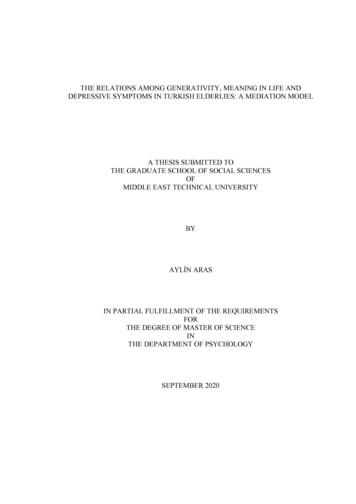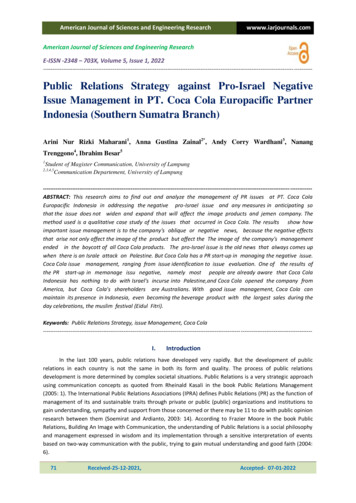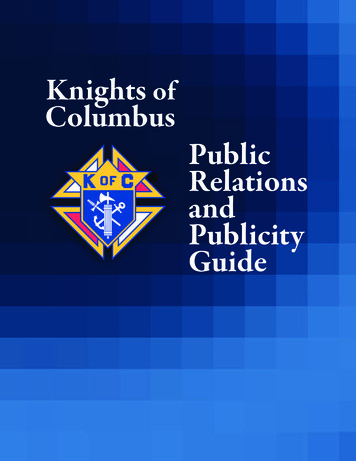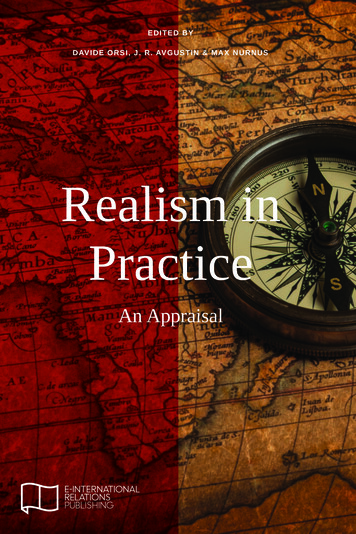
Transcription
THE RELATIONS AMONG GENERATIVITY, MEANING IN LIFE ANDDEPRESSIVE SYMPTOMS IN TURKISH ELDERLIES: A MEDIATION MODELA THESIS SUBMITTED TOTHE GRADUATE SCHOOL OF SOCIAL SCIENCESOFMIDDLE EAST TECHNICAL UNIVERSITYBYAYLİN ARASIN PARTIAL FULFILLMENT OF THE REQUIREMENTSFORTHE DEGREE OF MASTER OF SCIENCEINTHE DEPARTMENT OF PSYCHOLOGYSEPTEMBER 2020
Approval of the thesis:THE RELATIONS AMONG GENERATIVITY, MEANING IN LIFE ANDDEPRESSIVE SYMPTOMS IN TURKISH ELDERLIES: A MEDIATIONMODELsubmitted by AYLİN ARAS in partial fulfillment of the requirements for the degreeof Master of Science in Psychology, the Graduate School of Social Sciences ofMiddle East Technical University by,Prof. Dr. Yaşar KONDAKÇIDeanGraduate School of Social SciencesProf. Dr. Sibel KAZAK BERUMENTHead of DepartmentDepartment of PsychologyProf. Dr. Özlem BOZO ÖZENSupervisorDepartment of PsychologyExamining Committee Members:Prof. Dr. Bengi ÖNER ÖZKAN (Head of the Examining Committee)Middle East Technical UniversityDepartment of PsychologyProf. Dr. Özlem BOZO ÖZEN (Supervisor)Middle East Technical UniversityDepartment of PsychologyProf. Dr. Hatice DEMİRBAŞAnkara Hacı Bayram Veli UniversityDepartment of Psychology
PLAGIARISMI hereby declare that all information in this document has been obtained andpresented in accordance with academic rules and ethical conduct. I also declarethat, as required by these rules and conduct, I have fully cited and referenced allmaterial and results that are not original to this work.Name, Last Name: Aylin ARASSignature:iii
ABSTRACTTHE RELATIONS AMONG GENERATIVITY, MEANING IN LIFE ANDDEPRESSIVE SYMPTOMS IN TURKISH ELDERLIES: A MEDIATION MODELAras, AylinM.S., The Department of PsychologySupervisor: Prof. Dr. Özlem Bozo ÖzenSeptember 2020, 77 pagesThe aim of the present master’s thesis was to investigate the association betweengenerativity and depression, as well as the mediating role of meaning in life in thisassociation among Turkish elderly population. Data were collected from 152 olderindividuals aged between 65 and 88. The results of the current study revealed thatgenerativity was not associated with depression. Regarding the meaning in life,although the association between generativity and the search for meaning in life wasinsignificant, generativity was positively associated with the presence of meaning inlife. Similarly, while the presence of meaning in life was not associated with geriatricdepression, the search for meaning in life was positively associated with depression.The findings of mediation analysis revealed that neither the presence of meaning inlife nor the search for meaning in life mediated the association between generativityand depression among Turkish elderly individuals. The findings of the present studyiv
were discussed in light of the existing literature. The strengths and limitations of thestudy, clinical implications of the findings, and the directions for future research werepresented.Keywords: Generativity, Meaning in Life, Depression, Agingv
ÖZTÜRK YAŞLI NÜFUSUNDA ÜRETKENLİK, YAŞAMIN ANLAMI VEDEPRESİF BELİRTİLER ARASINDAKİ İLİŞKİLER: BİR ARABULUCULUKANALİZİAras, AylinYüksek Lisans, Psikoloji BölümüTez Yöneticisi: Prof. Dr. Özlem Bozo ÖzenSeptember 2020, 77 sayfaBu yüksek lisans tez çalışmasının amacı, Türkiye’deki yaşlı nüfusun üretkenlikdüzeyleri ve depresif semptomları arasındaki ilişkiyi ve bu ilişkide hayattaki anlamınaracı değişken rolünü incelemektir. Çalışmanın örneklemi yaşları 65 ve 88 arasındadeğişen 152 kişiden oluşmaktadır. Çalışmanın sonucunda, yaşlıların üretkenlikdüzeyleri ile depresif semptomları arasında anlamlı bir ilişki bulunamamıştır.Yaşamdaki anlamla ilgili olarak, üretkenlik ile yaşamdaki anlam arayışı arasındaanlamlı bir ilişki bulunamamasına rağmen, üretkenlik yaşamdaki anlamın varlığıylapozitif yönde bir ilişki göstermiştir. Benzer şekilde, yaşamda anlamın varlığı geriatrikdepresyon ile anlamlı bir ilişki göstermezken, yaşamda anlam arayışı depresyon ilepozitif yönde ilişki göstermiştir. Arabuluculuk analizi bulgularına göre, yaşamdaanlam varlığı ve anlam arayışının, yaşlı bireylerin üretkenlik düzeyleri ve depresifsemptomları arasındaki ilişkiye aracılık etmediği bulunmuştur. Çalışmanın bulgularıilgili alan yazın ışığında tartışılmış ve çalışmanın güçlü yönleri, sınırlılıkları,vi
bulguların klinik sonuçları tartışılarak gelecekteki araştırmalar için önerilersunulmuştur.Anahtar Kelimeler: Üretkenlik, Yaşamda Anlam, Depresyon, Yaşlılıkvii
DEDICATIONTo the little girl who gives me strength with her tiny smile viii
ACKNOWLEDGMENTSI want to express my appreciation to my master’s years at METU which brought meboth academic and personal growth, and to significant people who had touched on mylife in this process in some way. First of all, I want to express my deepest gratitude tomy dear supervisor, Özlem Bozo Özen, for her genuineness, support, and caringattitude that I deeply felt throughout my master’s education as well as her patience andguidance in my thesis writing process. I admire her scientific enthusiasm andhardworking nature. It was a privilege to walk this road with her. I also want to thankmy examining committee members, Prof. Dr. Bengi Öner-Özkan and Prof. Dr. HaticeDemirbaş for their time, valuable feedbacks and contributions. I am also grateful tomy dear professor Prof. Dr. Hatice Demirbaş for her tactfulness, support as well as hercontributions to my data collection process. Whenever we met, she did not forget toask my thesis even for a moment. I feel very lucky to have stepped into my first workexperience with her.I would like to express my sincere gratitude to Prof. Dr. A. Nuray Karancı. I alwaysfeel her invaluable contributions to me as an academician, a therapist and as a person.She has been a role model for me with her calm stance, understanding and lovingnature, and with her never-ending desire to learn and develop. It was an honor to betrained and supervised by her. I am also thankful to Assoc. Prof. Deniz Canel Çınarbaşfor her contributions to my training and her efforts to the program in general. I am verythankful to my supervisors Gökçen Bulut, İpek Demirok, Melisa A. Paker, GizemUzun not only for their invaluable contributions to my development as a clinicalpsychologist and psychotherapist but also stimulating me in the way of hearing myinner voice.I also thank to my lovely friends İdil Uğurluoğlu, Ebru Haskılıç, Kadriye Yılmaz andSemanur Güneş for their endless support, warmth hearth, genuineness and just forbeing themselves. It's blissful to feel that you are there!ix
My sincere thanks also go to all my colleagues and friends. I owe special thanks toHurigül Bayram Gülaçtı, Pınar Bulut, Zeynep Şaklar for their warmth, guidance andsupport despite my never-ending anxieties. I will always remember the bursts of angerwe experienced together, our lunches, with a bitter smile on my face. It was a pleasurefor me to work with you. Moreover, I also would like to deeply thank Hurigül since Icould not handle the data analysis without her guidance in a very limited time.My special thanks go to my lovely supervisor, colleague, and friend, Gökçen Bulut. Iam deeply grateful for her always supporting and heartening me in the decisions I havetaken in the last 1.5 years of my life despite all my ups and downs, worries and fears,and also, for shedding light on my deepest feelings with her calmness. I am alsothankful to her due to her contributions to me with her theoretical orientation blendedwith her personality on my way of becoming a therapist. Thank you for yournonjudgmental and caring attitude, and mostly, for sharing my happiness as much as Ido.Most importantly, I want to express my deepest appreciation to my mom, Gülsen Arasfor being my safe haven as well as her limitless efforts and sacrifices throughout mylife, to my beloved sisters, Dilek Uçar and Selin Aras, for always being with me andenduring all my stress (!), to my father, Sedat Aras, my lovely playmates, Ege andSena Uçar and to my brother in-law Hüseyin Uçar . Without their never-endingsupport, love and patience, I would not be the person as I am right now. Love you all In addition to all actors of my data collection process, I sincerely thank to my uncleHasan Aras, my aunt Gülten Çıray, and especially my cousin Pınar Çıray not only fortheir extensive efforts in the data collection process, but also their belief in me. I amalso thankful to the participants of the current study for their time, perseverance andtheir contributions. I gratefully remember those who passed away in this process. Theyleft me good memories with a handful of questions regarding the meaning of life. Thisthesis would not come through without the assistance of all these individuals.I would like to thank the Scientific and Technological Research Council of Turkey(TÜBİTAK) for financially supporting me throughout my graduate education process.x
TABLE OF CONTENTSPLAGIARISM . iiiABSTRACT .ivÖZ .viDEDICATION . viiiACKNOWLEDGMENTS .ixTABLE OF CONTENTS. xiiLIST OF TABLES. xiiiLIST OF FIGURES . xivCHAPTERS1. INTRODUCTION . 11.1. Older Adults and Depression . 11.1.1. Geriatric Depression . 31.2. What is Generativity?. 51.2.1. Generativity and Depression . 91.3. Meaning in Life . 121.3.1. Theoretical Background of Meaning in Life Literature . 131.3.2. Meaning in Life and Depression in Old Age . 161.3.3. Meaning in Life and Generativity . 181.4. General Aims and Hypotheses of the Current Study . 192. METHOD. 212.1. Participants . 212.2. Materials . 242.2.1. Demographic Information Form . 24xi
2.2.2. Mini-Mental State Examination (MMSE). 242.2.3. The Loyola Generativity Scale (LGS) . 252.2.4. Meaning in Life Questionnaire (MLQ) . 262.2.5. Geriatric Depression Scale (GDS) . 272.3. Procedure . 283. RESULTS . 293.1. Statistical Analysis . 293.2. Descriptive Analyses . 303.3. Bivariate Correlations among the Variables of the Study . 304. DISCUSSION . 33REFERENCES . 42APPENDICESAPPENDİX A. APPROVAL OF THE MIDDLE EAST TECHNICALUNIVERSITY HUMAN SUBJECTS ETHICS COMMITTEE. 53APPENDIX B. DEMOGRAPHIC INFORMATION FORM / DEMOGRAFİKBİLGİ FORMU. .54APPENDIC C. MINI-MENTAL STATE EXAMINATION (MMSE) / MİNİMENTAL DURUM TESTİ . .56APPENDIX D. THE LOYOLA GENERATIVITY SCALE (LGS) / LOYOLAÜRETKENLİK YAŞANTILARI ÖLÇEĞİ. .58APPENDIX E. MEANING IN LIFE QUESTIONNAIRE (MLQ) / YAŞAMINANLAMI ÖLÇEĞİ .59APPENDIX F. GERIATRIC DEPRESSION SCALE (GDS) / GERIATRIKDEPRESYON ÖLÇEĞİ . .60APPENDIX G. INFORMED CONSENT FORM / GÖNÜLLÜ KATILIMFORMU . .62APPENDIX H. TURKISH SUMMARY / TÜRKÇE ÖZET . 63APPENDIX I. THESIS PERMISSION FORM / TEZ İZİN FORMU. 77xii
LIST OF TABLESTable 1. Demographic Characteristics of the Sample .23Table 2. Descriptive Statistics for the Variables of the Study .30Table 3. Pearson’s Correlation Coefficients of the Study Variables 31xiii
LIST OF FIGURESFigure 1. Generativity and Depression with Presence of Meaning as the Mediator.32Figure 2. Generativity and Depression with Search for Meaning as the Mediator 32xiv
CHAPTER 1INTRODUCTION1.1. Older Adults and DepressionThe elderly population is growing rapidly all over the world and this rate of increaseis much faster than in the past [World Health Organization (WHO), 2018] and all otherage groups [United Nations (UN), Department of Economic and Social Affairs, 2019].According to World Bank data, the world population aged 65 and over constituted8.87% of total population in 2018 while it was only 4.97% of the total population in1960 (The World Bank Group, 2019). This dramatic increase in life expectancy andthe decrease in fertility rates are the key drivers of aging world population[Orimo et al., 2006; Podea & Palici, 2015; UN, 2019]. According to World PopulationProspects by 2050, 16% of the world population, or one in six people in the world, isexpected to be over the age of 65 although this rate was reported as 9% in 2019.Moreover, the number of individuals aged 80 and over is predicted to triple from143 million in 2019 to 426 million in 2050, and the average life expectancy isestimated to be 77.1 by 2050 (UN, 2019). However, it is expected that 80% of theolder population will be living in low- and middle-income countries by 2050. As oneof the developing/middle income countries, in parallel with world population trends,the proportion of the aging population is getting older in Turkey and this increase isoccurring at a greater rate than any other age groups [Turkish Statistical Institute(Türkstat), 2020]. According to the available data, the Turkish elderly population was9.1% relative to the total population in 2019, while it was only 3.5% in 1960. Thisproportion is expected to reach 25.6% in 2080. In the last five years, the growth ratein this age group reached to 7.550.727 people in 2019, an increase of 21.9%, whichshows the rapid pace of growth more dramatically (Türkstat, 2020). Therefore, it iscrucial to understand the older population and the features of this group of individuals1
in more detail, since this social transformation will give direction to the individual,family and society in the future.In most countries, people aged 65 and above are accepted as being elderly(Orimo et al., 2006; WHO, 2020) and the aging period is mostly equated with a timeof losses. As lifespans increase, older adults encounter many challenges, such asphysical constraints, health problems, loss of social contact through retirement,children leaving home, loss of spouses and friends, which in turn lead to loneliness,decreases in life satisfaction and increases in negative affectivity (Naef, Ward, MahrerImhof, & Grande, 2013; Rubio, Dumitrache, Cordon-Pozo, & Rubio-Herrera, 2016;Tanjanai, Moradinazar, & Najafi, 2017). Therefore, in older adulthood the process ofgetting used to life’s transitions mostly manifests itself as depression, which is one ation(Chang-Quan et al., 2010; Singh, Mazi-Koywal, & Thalitaya, 2015). It was indicatedthat nearly one-quarter of the elderlies show symptoms of clinical depression(Singh et al., 2015; Wolkowitz, Reus, & Mellon, 2011), and in Turkey, this rate wasreported as 18% in a study (Kulaksızoğlu et al., 2005). Given that the rate of olderadults growing in the population increases and their health-related quality of life isdeteriorated by depression (Ito & Matsushima, 2017; Silva et al., 2017), it is importantto understand the core psychological correlates of depression among elderlyindividuals.Not all individuals aged 65 and over experience clinical depression. There must be anumber of factors making life more meaningful for older adults, which in turn wouldprevent them from developing depressive symptoms and enable older adults to remainfunctional despite many losses experienced during this stage of life. Perhaps, asErikson stated, the period of old age may not be as negative as has been thought(2014/1982). In that sense, this study aims to provide a deeper understanding for theperiod of old age and some of the protective factors against depression in old age.Therefore, in the present study, the association between generativity and depressivesymptoms in elderly individuals will be studied. Moreover, the role of finding meaningin life in the association between generativity and depressive symptoms will beexamined in a Turkish elderly sample.2
1.1.1. Geriatric DepressionDepression is one of the most prevalent psychiatric disorders and a common cause ofdisability in adults aged 65 years and older. Community-based epidemiological studieshave reported the prevalence of major depression among the elderlies as ranging from1% to 5%, yet estimates for clinically significant symptoms of depression weresomewhat higher, ranging from approximately 8% to 16% worldwide (for a review,see Barua, Ghosh, Kar, & Basilio, 2011; Blazer, 2003; Fiske, Wetherell, &Gatz, 2009; McCall & Kintziger, 2013; Singh et al., 2015). However, it seems thatreports of the prevalence of depressive symptoms in adults aged 65 and over varysignificantly across studies due to differences in the methods and samples used(Beekman, Copeland, & Prince, 1999; Blazer, 2003) as well as in social, cultural andethnic characteristics of the communities in which the studies are carried out(Bretanha et al., 2015).When looking at the prevalence of geriatric depression in Turkey, it can be said thatthe rates are in line with world trends in elderly depression such that the prevalence ofdepression in those 65 and over was 10-20%, with significantly higher rates at thehigher end of the continuum (Kulaksızoğlu et al., 2005; Uçku & Küey, 1992). Forexample, in a study conducted with 147 individuals aged 65 and over, it was foundthat 17.7% of the sample had depression. This rate was significantly higher in women(Şimşek, Yümin, Sertel, Öztürk, & Yümin, 2010). Similarly, in a more recent study,while 53% of individuals aged 65 and over had mild depression, 39% had moderatedepression, and 7.7% had severe depression. Surprisingly, it was reported thatproportion of people with depression in old age bracket was higher than in other agegroups (Ağırman, Gençer, Arıca, Kaya, & Eğici, 2017; Fiske et al., 2009). In anotherstudy published in 2019, 27.6% of 323 randomly selected elderly people aging 65 andover showed depressive symptoms (Yılmaz & Karaca, 2020). Moreover, as expectedin Turkey, the rate of depression in treatment and care settings was higher thancommunity settings in concordance with world depression trends (Kaya, 1999). Thus,these findings, which are based on a standard measurement tool called the GeriatricDepression Scale (GDS), imply that in advanced adulthood, since depressivesymptoms manifested in a spectrum and rates fluctuate from sample to sample, it isdifficult to talk about precise rates of depression in older adults. Nevertheless, it is3
obvious that geriatric depression is seen in a significant proportion of older adults andit poses a serious public health problem threatening the well-being of this group ofindividuals.By its very nature, old age depression differs from its earlier presentations in terms ofits symptoms, etiology, risk factors and potential outcomes (Fiske et al., 2009). Forexample, older adults are less likely to manifest affective and biological symptoms andmore likely to endorse symptoms of psychomotor retardation, cognitive changes,somatic symptoms, sleep disturbances, low energy, loss of interest in living,hopelessness and excessive worries about the future compared to younger individualswith depression (for more information, see Blazer, 2003; Fiske et al., 2009;Singh et al., 2015). Moreover, regardless of the role of any predisposing factors, asmost of the studies – but not all – have reported, having low income, low education,dysfunctions in activities of daily living, being women, living alone, dissatisfactionwith life, having no leisure time activity and increased sedentary behavior areconsidered as potential risk factors for depression for that age group (Ağırman etal., 2017; Kaya, 1999; Kulaksızoğlu et al., 2005; McCall & Kintziger, 2013). In thesame vein, old age depression is associated with functional impairment, physical,cognitive and social disability (Blazer, 2003; McCall & Kintziger, 2013), reducedquality of life and life satisfaction (Şimşek et al., 2010). It is also characterized bylower rates of recovery and higher rates of suicide (Kaya, 1999; Şimşek et al., 2010).For instance, according to Türkstat 2013 data, the suicide rate was the highest amongpeople in the 75 and over with a ratio of 8.08 per 100.000 people (Turkstat, 2013), andolder adults are more likely than their younger counterparts to succeed in theirattempts. All of these effects in turn increase the risk of mortality (Blazer, 2003;Şimşek et al., 2010), lead to the inevitable utilization of health-care services andeconomic and social resources (Courtin & Knapp, 2017). Nevertheless, depression inlater life often goes unrecognized and untreated due to physicians’ underdiagnoses orolder adults’ not reporting symptoms as it is mostly seen as a part of normal aging, thesideeffectsofother(Eriksson et al., 2020;medicalGregg, Fiske,conditionsor& Gatz, 2013;fearsofstigmatizationKulaksızoğlu et al., 2005;Rodda, Walker, & Carter, 2011; Singh et al., 2015), which in turn further complicatesthe course of the depression. Thus, given its substantial prevalence, its negative courseand adverse outcomes for the individual, family and society in general, and4
considering the fact that little attention is given to late life depression, it is importantto understand the core psychological mechanisms that can prevent depression in olderadults to facilitate successful aging.1.2. What is Generativity?Generativity is one of the contributors to successful aging (Fisher, 1995; Villar, 2012).As an important psychological and developmental process, generativity was extgeneration”(Erikson, 1963, p. 267). The concept was first introduced by Erik Erikson more than55 years ago as part of his theory of psychosocial development. He proposed eight lifestages with each stage having its unique developmental challenges and crises that needto be appropriately resolved for healthy personality development to occur. Throughthe successful resolution of each stage, the individual acquires the competencies ofeach stage, which in turn ensures greater maturity and life-long psychological wellbeing (Erikson 1963, 1982).The crisis of generativity versus stagnation is the seventh of these eight life stages.Erikson (1963) considered generativity as the primary developmental tension ofmiddle adulthood. According to Erikson (1963; 2014/1982), building on successfullyresolved previous stages at this stage, the developmental necessity of “need to beneeded” becomes relatively dominant and turns into a meaningful crisis as a result ofthe influence of both internal impulses and social and cultural norms. During this stage,an adult is full of concerns of making the world a better place for younger generationsand leaving a legacy by giving back to society. In that sense, a generative personendeavors to bear, nurture and guide the next generation through the utilization ofpreviously developed repertoires (Ehlman & Ligon, 2012; Karacan, 2007). Thus, theconcept of generativity is closely linked with productivity, creativity and altruism, yetit cannot be fully explained by these constructs (Schoklitsch & Baumann, 2012).Being motivated by higher-order needs such as achieving ego-integrity together withthe belief in the goodness of the species (Erikson, 2014/1982), a generative adultmoves from a self-centered attitude to an other-centered orientation (Slater, 2003).However, not everyone finds a way, or feels a need, to contribute to others. Thesestagnated adults may feel disconnected or unproductive, or they may have a sense that5
they are not needed or useful. Erikson (2014/1982), nevertheless, argues that even inour most productive and creative individuals, this sense of stagnation may occur andthis perception may take over whomever is no longer actively involved in productivityissues.Generativity can be expressed in multiple ways. For Erikson, the best manifestation ofgenerativity occurs through parenting or related caring behaviors, such as when havinga child, bearing and raising children, looking after dependents etc. Erikson was alsoaware that not all parents are generative, and generativity cannot be restricted to thedomain of parenting (Erikson, 1963). One can also be generative without having achild. In generativity, there is also self-directed generative desires in the form person(Erikson, 2014/1982). Thus, generativity can be expressed in variety of ways, such asthrough mentoring, teaching, guiding the next generation, altruistic activities such asvolunteering, religious involvement, friendships, working and even in leisure-timeactivities (McAdams & de St Aubin, 1992). That is to say, any activities aimed towardbettering the world for current and future generations and fulfilling the need for“symbolic immortality” can be a way of achieving generativity as opposed toexperiencing stagnation crises (McAdams & de St. Aubin, 1992, p. 5).Erikson’s view of generativity as a discrete stage was disputed by several theoreticians.Kotre was the first to expand on the generativity construct based on Erikson’s ideas(Schoklitsch & Baumann, 2012). In spite of Erikson’s view of generativity as a onedimensional construct, Kotre (1984, 1996) proposed a multidimensional theory ofgenerativity. He described four major types of generativity, namely biological,parental, technical and cultural generativity. According to him, biological generativityinvolved producing, bearing and nursing offspring. Parental generativity wasexpressed via nurturing, loving and disciplining behaviors or initiating offspring, bethey biological or non-biological, to family structure and culture so as to secure thefamily in the future. Teaching specific abilities such as cooking, writing, reading toless skilled individuals pertains to technical generativity; and finally, endeavoring toconvey the cultural symbols and meanings of a society to younger generations is themeans of cultural generativity. Additionally, Kotre believed that one can express thesefour types of generativity either in an agentic or communal manner or both; and none6
of these four types of generativity is restricted to a particular life period of an adult(Karacan, 2007; Schoklitsch & Baumann, 2012). Moreover, building on the work ofKotre, Snarey et al. (1987) reconceptualized generativity as being composed of threedifferent facets including biological, parental and societal generativity. Muchemphasis was given to the role of parenting on the development of generativity, and itwas concluded that not all parenting is generative. For parenting to be generative, theremust be commitment and sacrifice on the part of the parent (Snarey, 1993). In thisway, Snarey’s developmental view of generativity made a substantial contribution tothe psychology literature regarding the role of fathers and parental involvement for theachievement of generativity.Despite Kotre’s (1984) and Snarey’s (1987) important theoretical formulations thatexpand on Erikson’s view of generativity, the research regarding this construct hasbeen sparse and unsystematic. The first attempt to organize these notions into asystematic framework was made by McAdams and de St. Aubin (1992). Unlike theErikson’s view of generativity as a construct “located within the individual,”McAdams and de St. Aubin reformulated the model of generativity by relating theperson to the social world -just like attachment- since they thought that generativitywas motivated by both cultural demands and inner needs. That is, McAdams andde St. Aubin (1992) saw generativity as a configuration of seven psychosocialfeatures, namely inner desire, cultural demands, conscious concern for the youngergenerations, belief in the goodness of the species, commitment to taking resp
Approval of the thesis: THE RELATIONS AMONG GENERATIVITY, MEANING IN LIFE AND DEPRESSIVE SYMPTOMS IN TURKISH ELDERLIES: A MEDIATION MODEL submitted by AYLİN ARAS in partial fulfillment of the requirements for the degree of Master of Science in Psychology, the Graduate School of Social Sciences of Middle East Technical University by, Prof. Dr. Yaşar KONDAKÇI










